Researchers are exploring ocean iron fertilization as a potential method for removing atmospheric carbon dioxide, emphasizing the need for controlled trials to determine its effectiveness and ecological impact in combating climate change.

With the need to urgently reduce atmospheric carbon dioxide (CO2), ocean iron fertilization (OIF) is being revisited as a possible method for marine carbon dioxide removal (mCDR). In a study published in Frontiers in Climate, researchers, including oceanographers from the University of Hawai‘i, examined OIF as a scalable, low-cost solution. OIF involves adding iron to the ocean’s surface to promote the growth of phytoplankton, which can absorb CO2. However, scientists caution that more research is needed to determine the technique’s effectiveness and potential ecological impacts.
Previous experiments with OIF showed that while it promotes plankton growth, it may not reduce atmospheric CO2 on the scale required to make a significant difference. Despite this uncertainty, the researchers stress that inaction is not an option, given the urgent need to address climate change. Controlled ocean trials are necessary to understand how long iron remains in the water, how much carbon can be stored, and what ecological changes may occur. As Professor Angelicque White from UH Mānoa highlights, responsible and transparent research is essential to determining whether OIF can buy time while efforts to reduce emissions continue.
The study outlines five key research activities, including field studies in the Pacific Ocean, modeling of OIF impacts, testing different iron delivery methods, and developing monitoring systems for carbon storage and ecological changes. The scientific community has also called for expanded research, with over 400 scientists supporting efforts to better understand mCDR techniques like OIF. The researchers emphasize that any deployment of OIF must be coupled with responsible governance and social science to ensure ethical and effective implementation.
FULL STORY: Could adding iron to the ocean solve some climate change problems?

Alabama: Trump Terminates Settlements for Black Communities Harmed By Raw Sewage
Trump deemed the landmark civil rights agreement “illegal DEI and environmental justice policy.”

Planetizen Federal Action Tracker
A weekly monitor of how Trump’s orders and actions are impacting planners and planning in America.

The 120 Year Old Tiny Home Villages That Sheltered San Francisco’s Earthquake Refugees
More than a century ago, San Francisco mobilized to house thousands of residents displaced by the 1906 earthquake. Could their strategy offer a model for the present?

Ken Jennings Launches Transit Web Series
The Jeopardy champ wants you to ride public transit.

BLM To Rescind Public Lands Rule
The change will downgrade conservation, once again putting federal land at risk for mining and other extractive uses.

Indy Neighborhood Group Builds Temporary Multi-Use Path
Community members, aided in part by funding from the city, repurposed a vehicle lane to create a protected bike and pedestrian path for the summer season.
Urban Design for Planners 1: Software Tools
This six-course series explores essential urban design concepts using open source software and equips planners with the tools they need to participate fully in the urban design process.
Planning for Universal Design
Learn the tools for implementing Universal Design in planning regulations.
Clanton & Associates, Inc.
Jessamine County Fiscal Court
Institute for Housing and Urban Development Studies (IHS)
City of Grandview
Harvard GSD Executive Education
Toledo-Lucas County Plan Commissions
Salt Lake City
NYU Wagner Graduate School of Public Service




























